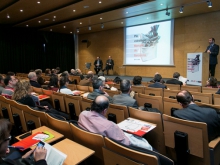Pécs
Hungary’s fifth largest city, with a population of 157,000, Pécs is located in the southwest of the country near the border with Croatia. The site of a Roman town, the various cultural and architectural layers of the city have settled in an unlikely order: the culture of Pécs was Latin when the university was established in 1367, Turkish in the 17th century as a part of the Ottoman Empire, German and Latin at the end of the 18th century and primarily Hungarian in the 20th century. The Turkish mosque on the main square is now a Catholic church. The Turkish half moon and the Catholic cross on the top of the mosque aptly symbolise the coexistence of cultures.
The city was a European Capital of Culture in 2010, an award that coincided with a significant level of EU investment. Along with restoration work, three major projects were completed—two new landmark buildings in the 13,000m² South Transdanubial Regional Library & Knowledge Centre, and the Kodály Conference and Concert Centre, plus the redevelopment of the 5-hectare area of porcelain manufacture as the Zsolnay Cultural Quarter. Other sites that add to the town’s tourism appeal are its early Christian necropolis, a UNESCO World Heritage Site, and the main square.
Pécs’ university is the largest in the country with 24,000 students, and the service and knowledge sectors have an important role to play in the local economy. Located in the centre of an agricultural region, Pécs acts as a local market for produce. In terms of industry, the trend is towards high-technology, logistics and food processing—based in new industrial parks.
SOME RELATED NETWORKS
URBACT Markets
UNIC
News
Want to become an expert in EU funds from your desk? Register for the Committee of the Regions MOOC!
News
Barcelona presents 2015-2025 Strategic Plan for City Markets
News
Renewing old markets, a tool for cities
News
Special Report - Launch of URBACT Training for Politicians on Sustainable Development
News







